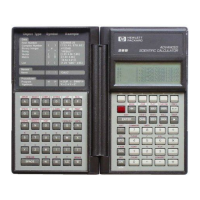HP-28S
Programs
General
• A program is a series of commands surrounded by << and >>
brackets. These symbols are located next to the SPACE key.
• The programming language is called RPL: Reverse Polish Lisp. It
is stack based with a support for many data types. The HP-28C/S
was the first calculator to use RPL. Later models like the HP-48
and HP-49 used it as well.
• Control instructions are described in the CONTRL Menu
• Branching instructions are descibed in the BRANCH Menu
• Flag manipulation and other program commands are described in
MENU Test
• Programs can be stored in variables like other objects.
See Data Types.
• There is no GOTO available. Use structured programming instead.
• Programs can be interrupted by pressing "ON".
Program example
<<ROT * SWAP 2 / CHS DUP SQ ROT - √ >> 'QE' STO
• Program QE takes 3 input values from the stack which represent
coefficients a, b and c of a quadratic equation.
• The program returns two values r1 and r2 on the stack. The two
solutions of the quadratic equation can be calculated as r1+r2
and r1-r2.
Local Variables A program can have local variables.
Using local variables avoids conflicts with global variable names.
Example: <<→ x y <<x y + LN>> >> 'P' STO
This creates the program and stores it in a variable called P.
Important: The SPACE after the "→" is required!
The program takes two arguments from the stack and puts them into
the local variables x and y. The return value is ln(x+y).
Example: 1 2 P returns 1.0986…
This program could also be entered in the form of an expression:
<< → x y 'LN(x+y)' >> 'P' STO
Both the program and expression form allows to invoke the program
in functional notation.
Example: 'P(1,2)' EVAL also returns 1.0986…
Important: For some reason the sequence P(1,2) ENTER will not
work but rather issue and error.
Editing a
program
• Use 'P' VISIT to bring back the program into the command
line for editing.
• Use NEWLINE to enter line breaks to make the program code
more readable.
Comparisn
operators
> ≥ < ≤ == ≠ and flag checking commands return either 0 or 1 onto
the stack and can be used to steer branch instructions.
Note that the values to be compared must be present on the stack.
Example: 4 5 > returns 0.
For more details see TEST Menu.
Subroutines Simply specify the name of the program to execute. Example:
<< SQ LN 1 + >> 'P1' STO
<< P1 SWAP P1 + >> 'P2' STO
7

